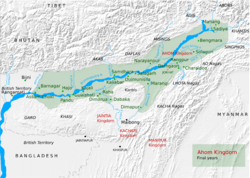| Years | Reign | Ahom name | Other names | Succession | End of reign | Capital |
|---|
|
| 1228–1268 | 40y | Sukaphaa | | | natural death | Charaideo |
| 1268–1281 | 13y | Suteuphaa | | son of Sukaphaa | natural death | Charaideo |
| 1281–1293 | 8y | Subinphaa | | son of Suteuphaa | natural death | Charaideo |
| 1293–1332 | 39y | Sukhaangphaa | | son of Subinphaa | natural death | Charaideo |
| 1332–1364 | 32y | Sukhrangpha | | son of Sukhaangphaa | natural death | Charaideo |
| 1364–1369 | 5y | Interregnum [8] | | | | |
| 1369–1376 | 7y | Sutuphaa | | brother of Sukhrangphaa [9] | assassinated [10] | Charaideo |
| 1376–1380 | 4y | Interregnum | | | | |
| 1380–1389 | 9y | Tyao Khamti | | brother of Sutuphaa | assassinated [11] | Charaideo |
| 1389–1397 | 8y | Interregnum | | | | |
| 1397–1407 | 10y | Sudangphaa | Baamuni Konwar | son of Tyao Khaamti [12] | natural death | Charagua |
| 1407–1422 | 15y | Sujangphaa | | son of Sudangphaa | natural death | |
| 1422–1439 | 17y | Suphakphaa | | son of Sujangpha | natural death | |
| 1439–1488 | 49y | Susenphaa | | son of Suphakphaa | natural death | |
| 1488–1493 | 5y | Suhenphaa | | son of Susenphaa | assassinated [13] | |
| 1493–1497 | 4y | Supimphaa | | son of Suhenphaa | natural death | |
| 1497–1539 | 42y | Suhungmung | Swarganarayan,
Dihingiaa Rojaa I | son of Supimphaa | assassinated [14] | Bakata |
| 1539–1552 | 13y | Suklenmung | Garhgayaan Rojaa | son of Suhungmung | natural death | Garhgaon |
| 1552–1603 | 51y | Sukhaamphaa | Khuraa Rojaa | son of Suklenmung | natural death | Garhgaon |
| 1603–1641 | 38y | Susenghphaa | Prataap Singha,
Burhaa Rojaa,
Buddhiswarganarayan | son of Sukhaamphaa | natural death | Garhgaon |
| 1641–1644 | 3y | Suramphaa | Jayaditya Singha,
Bhogaa Rojaa | son of Susenghphaa | deposed [15] | Garhgaon |
| 1644–1648 | 4y | Sutingphaa | Noriyaa Rojaa | brother of Suramphaa | deposed [16] | Garhgaon |
| 1648–1663 | 15y | Sutamla | Jayadhwaj Singha,
Bhoganiyaa Rojaa | son of Sutingphaa | natural death | Garhgaon/Bakata |
| 1663–1670 | 7y | Supangmung | Chakradhwaj Singha | cousin of Sutamla [17] | natural death | Bakata/Garhgaon |
| 1670–1672 | 2y | Sunyatphaa | Udayaditya Singha | brother of Supangmung [18] | deposed [19] | |
| 1672–1674 | 2y | Suklamphaa | Ramadhwaj Singha | brother of Sunyatphaa | poisoned [20] | |
| 1674–1675 | 21d | Suhung [21] | Samaguria Rojaa Khamjang | Samaguria descendant of Suhungmung | deposed [22] | |
| 1675–1675 | 24d | | Gobar Roja | great-grandson of Suhungmung [23] | deposed [24] | |
| 1675–1677 | 2y | Sujinphaa [25] | Arjun Konwar,
Dihingia Rojaa II | grandson of Pratap Singha, son of Namrupian Gohain | deposed, suicide [26] | |
| 1677–1679 | 2y | Sudoiphaa | Parvatia Rojaa | great-grandson of Suhungmung [27] | deposed, killed [28] | |
| 1679–1681 | 3y | Sulikphaa | Ratnadhwaj Singha,
Loraa Rojaa | Samaguria family | deposed, killed [29] | |
| 1681–1696 | 15y | Supaatphaa | Gadadhar Singha | son of Gobar Rojaa | natural death | Borkola |
| 1696–1714 | 18y | Sukhrungphaa | Rudra Singha | son of Supaatphaa | natural death | Rangpur |
| 1714–1744 | 30y | Sutanphaa | Siba Singha | son Sukhrungphaa | natural death | |
| 1744–1751 | 7y | Sunenphaa | Pramatta Singha | brother of Sutanphaa | natural death | |
| 1751–1769 | 18y | Suremphaa | Rajeswar Singha | brother of Sunenphaa | natural death | |
| 1769–1780 | 11y | Sunyeophaa | Lakshmi Singha | brother of Suremphaa | natural death | |
| 1780–1795 | 15y | Suhitpangphaa | Gaurinath Singha | son of Sunyeophaa | natural death | Jorhat |
| 1795–1811 | 16y | Suklingphaa | Kamaleswar Singha | great-grandson of Lechai, the brother of Rudra Singha [30] | natural death, smallpox | Jorhat |
| 1811–1818 | 7y | Sudingphaa (1) | Chandrakaanta Singha | brother of Suklingphaa | deposed [31] | Jorhat |
| 1818–1819 | 1y | | Purandar Singha (1) | descendant of Suremphaa [31] | deposed [32] | Jorhat |
| 1819–1821 | 2y | Sudingphaa (2) | Chandrakaanta Singha | | fled the capital [33] | |
| 1821–1822 | 1y | | Jogeswar Singha | 5th descendant of Jambor, the brother of Gadadhar Singha. Jogeswar was brother of Hemo Aideo, and was puppet of Burmese ruler [34] | removed [35] | |
| 1833–1838 | | | Purandar Singha (2) [36] | | | |


